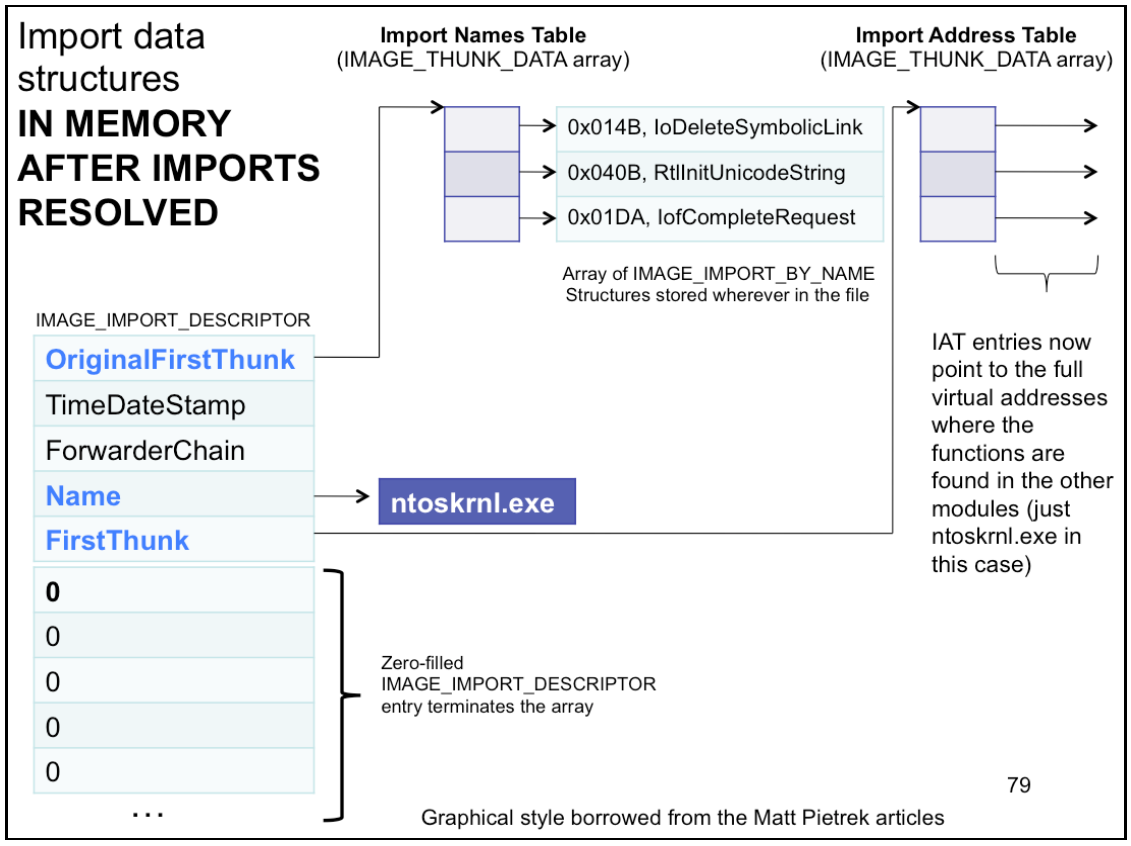Source
- https://opensecuritytraining.info/LifeOfBinaries.html
- https://www.youtube.com/playlist?list=PLUFkSN0XLZ-n_Na6jwqopTt1Ki57vMIc3
Class Scope

Tl;dr of this course
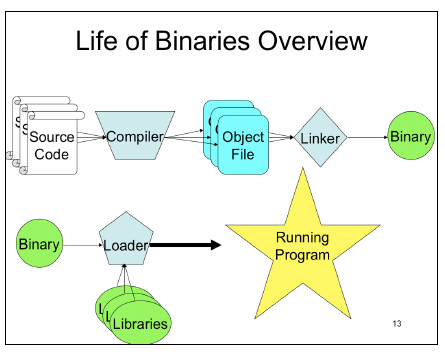
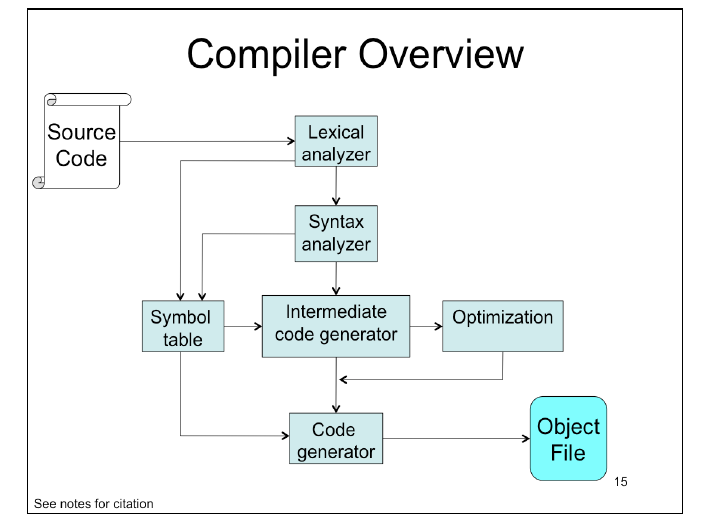
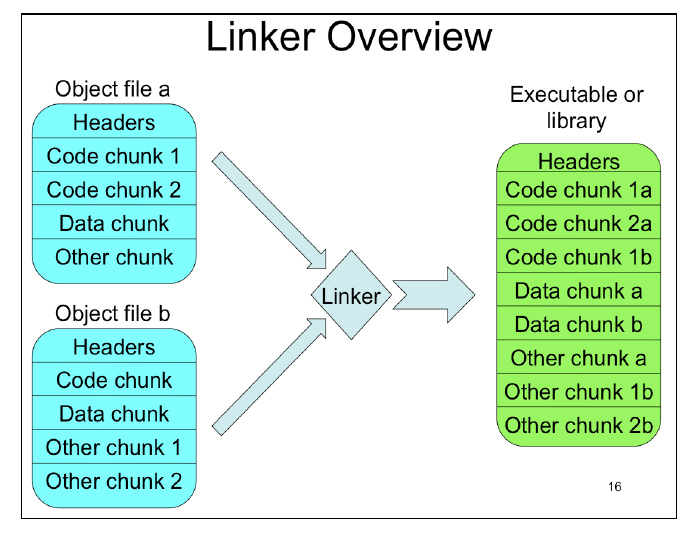
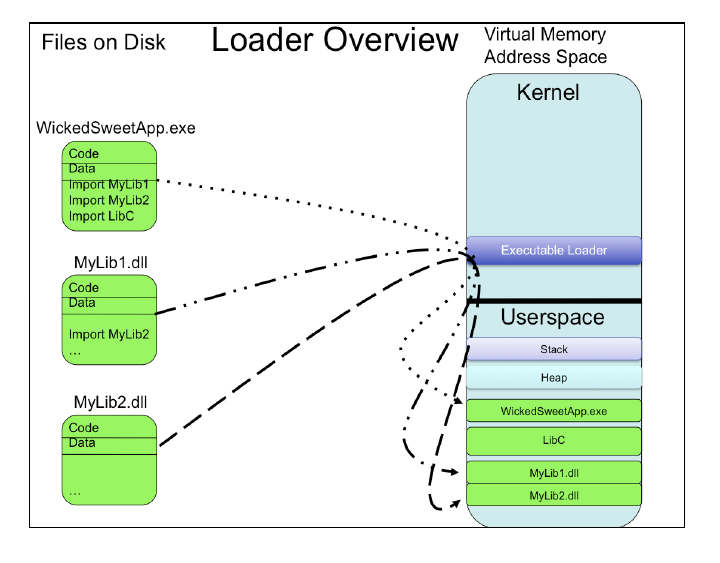
Go read the slides instead >:V
Different target binary formats
- Executable (
.exeon Windows, no suffix on Linux): A program which will either stand completely on its own, containing all code necessary for its execution, or which will request external libraries that it will depend on - Dynamic Linked Library (
.dll) on Windows == Shared Library aka Shared Object (.so) on Linux- neded to be loaded by some other program to run
- the library may have codes that will also be automatically executed at load time (
DllMain()on Windows andinit()on Linux)
- Static Library
.libon Windows.aon Linux- a collection of object files, with specific header info to describe the organization of the files
- will not execute anything on its own, only provides code to other program
Common Windows PE File Extensions
.exe.dll.sys.ocx.cpl.scr- Note:
.libfiles don’t have “DOS Header and then PE Header” format like the rest
PE File structure - WINNT.h
Terminology
- RVA - Relative Virtual Address: indicates some displacement relative to the start (base) of a binary in memory
- AVA - Absolute Virtual Address (sometimes just Virtual Address): a specific address memory where something can be found
- example: if base is
0x80000000, and the AVA was0x80001000, the RVA would be0x1000 - if the base is
0x80000000, and AVA was0xC123000F, then RVA would be0x4123000f - RVA = VA - base
- Windows use RVA exensively in PE Format, unlike ELF which uses just AVA
- example: if base is
- Windows uses:
CHAR= character = 1 byteWORD= word = 2 bytesSHORT= short integer = 2 bytesDWORD= double-word = 4 bytesLONG= long integer = 4 bytesQWORD= quad-word = 8 bytesLONGLONG= long long integer = 8 bytes
_IMAGE_DOS_HEADER - MS-DOS File Header
typedef struct _IMAGE_DOS_HEADER { // DOS .EXE header
WORD e_magic; // Magic number
WORD e_cblp; // Bytes on last page of file
WORD e_cp; // Pages in file
WORD e_crlc; // Relocations
WORD e_cparhdr; // Size of header in paragraphs
WORD e_minalloc; // Minimum extra paragraphs needed
WORD e_maxalloc; // Maximum extra paragraphs needed
WORD e_ss; // Initial (relative) SS value
WORD e_sp; // Initial SP value
WORD e_csum; // Checksum
WORD e_ip; // Initial IP value
WORD e_cs; // Initial (relative) CS value
WORD e_lfarlc; // File address of relocation table
WORD e_ovno; // Overlay number
WORD e_res[4]; // Reserved words
WORD e_oemid; // OEM identifier (for e_oeminfo)
WORD e_oeminfo; // OEM information; e_oemid specific
WORD e_res2[10]; // Reserved words
LONG e_lfanew; // File address of new exe header
} IMAGE_DOS_HEADER, *PIMAGE_DOS_HEADER;We’ll focus on
e_magic- set to ASCII ‘MZ’, which is from Mark Zbikowski, who developed MS-DOS
- most Windows program, the DOS header contains a stub DOS Program which prints out “THis program cannot be run in DOS mode”, that’s it :v
e_lfanew- specify file offset where PE Header can be found (some sort of file pointer)
_IMAGE_NT_HEADERS - PE Header
typedef struct _IMAGE_NT_HEADERS64 {
DWORD Signature;
IMAGE_FILE_HEADER FileHeader;
IMAGE_OPTIONAL_HEADER64 OptionalHeader;
} IMAGE_NT_HEADERS64, *PIMAGE_NT_HEADERS64;
typedef struct _IMAGE_NT_HEADERS {
DWORD Signature;
IMAGE_FILE_HEADER FileHeader;
IMAGE_OPTIONAL_HEADER32 OptionalHeader;
} IMAGE_NT_HEADERS32, *PIMAGE_NT_HEADERS32;Note: this is a bit different from OpenRCE’s PE Format references and the slide because I take it directly from mingw64’s source code
- Signature ==
0x00004550or ASCII string “PE” in little endian order in DWORD - Just a holder for 2 other embedded structs
_IMAGE_FILE_HEADER - File Header
typedef struct _IMAGE_FILE_HEADER {
WORD Machine;
WORD NumberOfSections;
DWORD TimeDateStamp;
DWORD PointerToSymbolTable;
DWORD NumberOfSymbols;
WORD SizeOfOptionalHeader;
WORD Characteristics;
} IMAGE_FILE_HEADER, *PIMAGE_FILE_HEADER;- Machine: specify what architecture this is supposed to run on(ex: 32bits or 64bits)
- 014C == x86 binary, aka PE32 binary
- 8664 == x64 binary, aka PE32+ binary
- NumberOfSections: tells you how many section headers there will be later
- TimeDateStamp: Unix timestamp
- second since epoc, epoc is 00:00:00 UTC on January 1st 1970
- set at link time
- can be used to track how many version there is (Investigation technique)
- can be used to know when a file was linked (forensic technique)
- Characteristics: specify things like
#define IMAGE_FILE_EXECUTABLE_IMAGE 0x0002 // File is executable (i.e. no unresolved externel references).
#define IMAGE_FILE_LINE_NUMS_STRIPPED 0x0004 // Line nunbers stripped from file.
#define IMAGE_FILE_LARGE_ADDRESS_AWARE 0x0020 // App can handle >2gb addresses
#define IMAGE_FILE_32BIT_MACHINE 0x0100 // 32 bit word machine.
#define IMAGE_FILE_SYSTEM 0x1000 // System File.
#define IMAGE_FILE_DLL 0x2000 // File is a DLL.
- SizeOfOptionalHeader can theoretically be shrunk to exclude “data directory” field, which the linker doesn’t need to include.
- PointerToSymbolTable, NumberOfSymbols not used anymore
- Note that all these fields can be manipulated by malware makers when dealing with malwares
BinaryScavengerHunt
This game is in Python 2.7, which is a very old version of Python.
note to self:
- rewrite the code in python 3.x if you have time
- write a guide to setup virtual environment in Python 2.7 or any Python version for different purposes using PyEnv
_IMAGE_OPTIONAL_HEADER
typedef struct _IMAGE_OPTIONAL_HEADER {
//
// Standard fields.
//
WORD Magic;
BYTE MajorLinkerVersion;
BYTE MinorLinkerVersion;
DWORD SizeOfCode;
DWORD SizeOfInitializedData;
DWORD SizeOfUninitializedData;
DWORD AddressOfEntryPoint;
DWORD BaseOfCode;
DWORD BaseOfData;
//
// NT additional fields.
//
DWORD ImageBase;
DWORD SectionAlignment;
DWORD FileAlignment;
WORD MajorOperatingSystemVersion;
WORD MinorOperatingSystemVersion;
WORD MajorImageVersion;
WORD MinorImageVersion;
WORD MajorSubsystemVersion;
WORD MinorSubsystemVersion;
DWORD Win32VersionValue;
DWORD SizeOfImage;
DWORD SizeOfHeaders;
DWORD CheckSum;
WORD Subsystem;
WORD DllCharacteristics;
DWORD SizeOfStackReserve;
DWORD SizeOfStackCommit;
DWORD SizeOfHeapReserve;
DWORD SizeOfHeapCommit;
DWORD LoaderFlags;
DWORD NumberOfRvaAndSizes;
IMAGE_DATA_DIRECTORY DataDirectory[IMAGE_NUMBEROF_DIRECTORY_ENTRIES];
} IMAGE_OPTIONAL_HEADER32, *PIMAGE_OPTIONAL_HEADER32;typedef struct _IMAGE_OPTIONAL_HEADER64 {
WORD Magic;
BYTE MajorLinkerVersion;
BYTE MinorLinkerVersion;
DWORD SizeOfCode;
DWORD SizeOfInitializedData;
DWORD SizeOfUninitializedData;
DWORD AddressOfEntryPoint;
DWORD BaseOfCode;
ULONGLONG ImageBase;
DWORD SectionAlignment;
DWORD FileAlignment;
WORD MajorOperatingSystemVersion;
WORD MinorOperatingSystemVersion;
WORD MajorImageVersion;
WORD MinorImageVersion;
WORD MajorSubsystemVersion;
WORD MinorSubsystemVersion;
DWORD Win32VersionValue;
DWORD SizeOfImage;
DWORD SizeOfHeaders;
DWORD CheckSum;
WORD Subsystem;
WORD DllCharacteristics;
ULONGLONG SizeOfStackReserve;
ULONGLONG SizeOfStackCommit;
ULONGLONG SizeOfHeapReserve;
ULONGLONG SizeOfHeapCommit;
DWORD LoaderFlags;
DWORD NumberOfRvaAndSizes;
IMAGE_DATA_DIRECTORY DataDirectory[IMAGE_NUMBEROF_DIRECTORY_ENTRIES];
} IMAGE_OPTIONAL_HEADER64, *PIMAGE_OPTIONAL_HEADER64;- The first thing about Optional Header is that it’s not Optional
Magicis the true determinant of PE32 or PE32+0x10B== 32bits, or PE320x20B== 64bits, or PE32+
AddressOfEntryPoint: specifies the RVA of where loader starts executing code once it’s completed loading the binary. Don’t assume it points to the beginning of.textor start ofmain()SizeOfImage: the amount of contiguous memory must be preserved to load the binary into memorySectionAlignment: specifies that sections must be aligned on boundaries which are multiplies of this value- ex: if it was
0x1000, then you might expect to see sections starting at0x1000,0x2000,0x5000, etc
- ex: if it was
FileAlignment: data was written to binary in chunks no smaller than this value.- ex:
0x200, which is 512, the size of HD sector, or0x80, the size of a floppy disk sector (does people still uses floppy disk?)
- ex:
ImageBase: specifies the preferred virtual memory location where the binary should be placed- M$ recommend developers “rebase” DLL files. It means that people should picking a non-default memory address which will not conflict with any of the other libraries (which will be loaded into the same memory space)
- If the binary can’t be loaded at
ImageBase(e.g. because another thing is already using that memory) then the loader picks an unused memory range. Then, every location in the binary which was compiled assuming that the binary was loaded atImageBasemust be fixed by adding the difference between the newImageBase- the actualImageBase - the list of places which must be fixed is kept in
.reloc(relocations) section - M$ doesn’t support position-independent code
DLLCharacteristics: specifies some important security options like ASLR and non-executable memory regions for the loader, and the effects aren’t limited to DLLs
#define IMAGE_DLLCHARACTERISTICS_DYNAMIC_BASE 0x0040
// DLL can move.
#define IMAGE_DLLCHARACTERISTICS_FORCE_INTEGRITY 0x0080
// Code Integrity Image
#define IMAGE_DLLCHARACTERISTICS_NX_COMPAT 0x0100
// Image is NX compatible
#define IMAGE_DLLCHARACTERISTICS_NO_SEH 0x0400
// Image does not use SEH. No SE handler may reside in this imageIMAGE_DLLCHARACTERISTICS_DYNAMIC_BASE: set when linked with/DYNAMICBASEoption. This flag tells OS loader that this binary support ASLR. Must be used with/FIXED:NOoptions for.exefiles, otherwise they won’t get relocation informationIMAGE_DLLCHARACTERISTICS_FORCE_INTEGRITY: check at load time whether the digitally signed hash of the binary matchesIMAGE_DLLCHARACTERISTICS_NX_COMPAT: set with the/NXCOMPATlinker option, tells the loader that this image is compatible with Data Execution Prevention (DEP) and that non-executable sections should have NX flag set in memory (I haven’t take the Intermediate x86 course yet…)IMAGE_DLLCHARACTERISTICS_NO_SEH: says that this binary never uses structured exception handling, therefore no default handler should be created (because in the absence of other options that SEH handler is potentially vulnerable to attack)
Security-relevant Linker Options
/DYNAMICBASE- Mark the properties to indicate that this executable will work fine with ASLR (Address Space Layout Randomization)/FIXED:NO- This will force the linker to generate relocations information for an executable, so that it’s capable of having its base address modified by ASLR (otherwise usually.exefiles don’t have relocations information, therefore can’t be moved around in memory)/NXCOMPAT- mark the properties to indicate that this executable will work fine with Data Execution Prevention (DEP) (which marks data memory regions such as stack and heap as non-executable). DEP is M$‘s name for utilizing NX/XD bit to mark memory pages as non-executable (intermediate x86 course again…)/SAFESEH- Safe Structured Exception Handling. Enforces that the only SEH things you can use are ones which are specified in the binary (it will automatically add any ones defined in your code to a list that will be talked about later)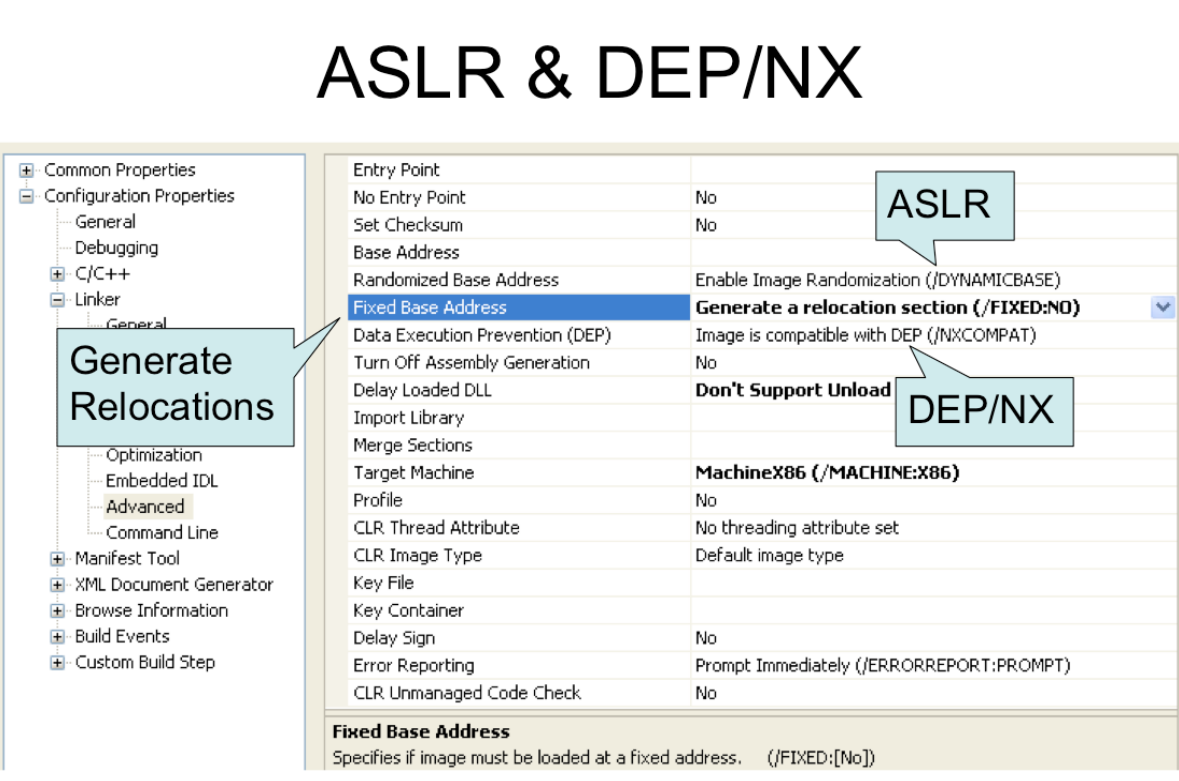
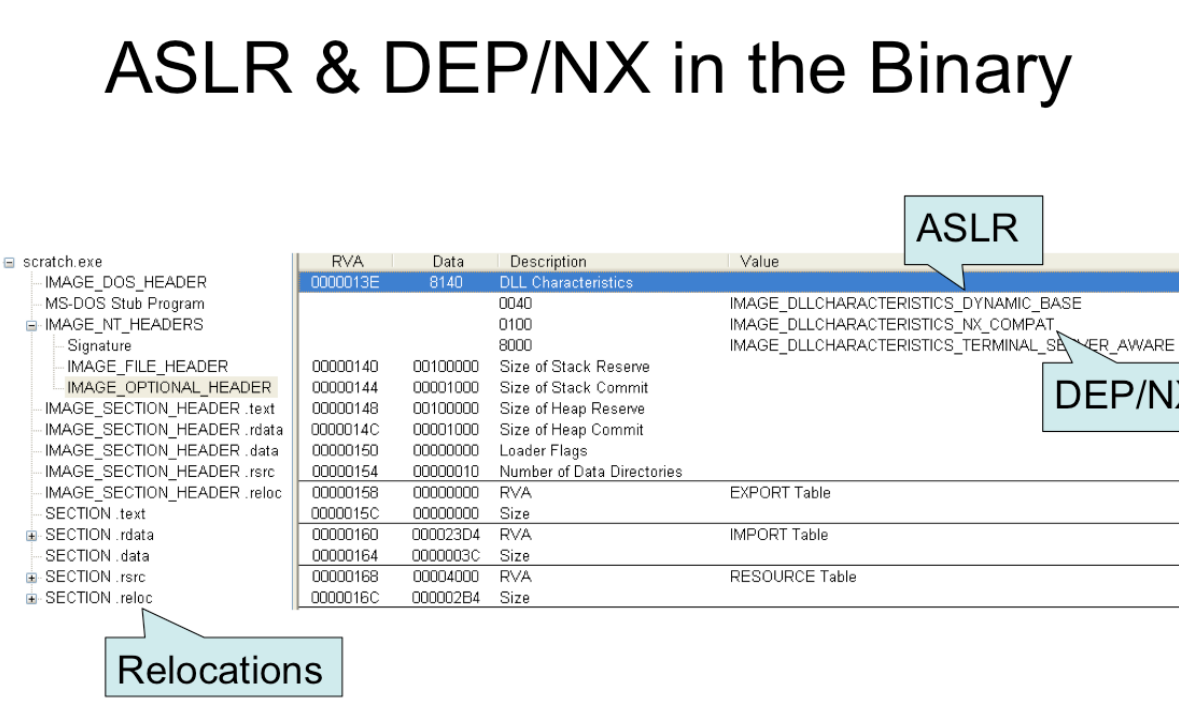
DataDirectory[16]: this is actuallyIMAGE_DATA_DIRECTORY
typedef struct _IMAGE_DATA_DIRECTORY {
DWORD VirtualAddress;
DWORD Size;
} IMAGE_DATA_DIRECTORY, *PIMAGE_DATA_DIRECTORY;VirtualAddressis a RVA Pointer to some other structure of givenSize
// Directory Entries
#define IMAGE_DIRECTORY_ENTRY_EXPORT 0 // Export Directory
#define IMAGE_DIRECTORY_ENTRY_IMPORT 1 // Import Directory
#define IMAGE_DIRECTORY_ENTRY_RESOURCE 2 // Resource Directory
#define IMAGE_DIRECTORY_ENTRY_EXCEPTION 3 // Exception Directory
#define IMAGE_DIRECTORY_ENTRY_SECURITY 4 // Security Directory
#define IMAGE_DIRECTORY_ENTRY_BASERELOC 5 // Base Relocation Table
#define IMAGE_DIRECTORY_ENTRY_DEBUG 6 // Debug Directory
// IMAGE_DIRECTORY_ENTRY_COPYRIGHT 7 // (X86 usage)
#define IMAGE_DIRECTORY_ENTRY_ARCHITECTURE 7 // Architecture Specific Data
#define IMAGE_DIRECTORY_ENTRY_GLOBALPTR 8 // RVA of GP
#define IMAGE_DIRECTORY_ENTRY_TLS 9 // TLS Directory
#define IMAGE_DIRECTORY_ENTRY_LOAD_CONFIG 10 // Load Configuration Directory
#define IMAGE_DIRECTORY_ENTRY_BOUND_IMPORT 11 // Bound Import Directory in headers
#define IMAGE_DIRECTORY_ENTRY_IAT 12 // Import Address Table
#define IMAGE_DIRECTORY_ENTRY_DELAY_IMPORT 13 // Delay Load Import Descriptors
#define IMAGE_DIRECTORY_ENTRY_COM_DESCRIPTOR 14 // COM Runtime descriptor- only 15 are defined for an array of 16 elements, huh.
BinHunt round 2
go play it yourself >:(
Sections
Common section names:
.text= Code which should never be paged out of memory to disk.data= read/write data (globals).rdata= read-only data (strings).bss= Block Started by Symbol- or Block Storage Segment
- or Block Storage Start (that’s 2 name too many lmao).
- The CMU Architecture book says the last one so…
- M$ specs says of .bss as “Uninitialized data (free format)” which is the same as for ELF
- In practice, the .bss seems to be merged into .data section by the linker for the binaries
.idata= Import address table. Gets merged with .text or .rdata.edata= Export informationPAGE*= Code/data which it’s fine to page out to disk when computer’s running low on memory (seems to be used primarily for kernel drivers).reloc= Relocation information for where to modify hardcoded addresses which assume that it was loaded atImageBasethat is mentioned above..rsrc= Resources. Lots of possible stuff from icons to other embedded binaries. Has structures organizing it sort of like a filesystem..pdata= ARM, MIPS, SH Windows CE compilers use PDATA structure to aid in stack walking at run-time. This structure aids in debugging and exception processing.- or at least that’s what MDSN saids
_IMAGE_SECTION_HEADER - Section Header
#define IMAGE_SIZEOF_SHORT_NAME 8
typedef struct _IMAGE_SECTION_HEADER {
BYTE Name[IMAGE_SIZEOF_SHORT_NAME]; // Name[8]
union {
DWORD PhysicalAddress;
DWORD VirtualSize;
} Misc;
DWORD VirtualAddress;
DWORD SizeOfRawData;
DWORD PointerToRawData;
DWORD PointerToRelocations;
DWORD PointerToLinenumbers;
WORD NumberOfRelocations;
WORD NumberOfLinenumbers;
DWORD Characteristics;
} IMAGE_SECTION_HEADER, *PIMAGE_SECTION_HEADER;- Name[8] is a byte array of ASCII character. NOT guaranteed to be null-terminated
VirtualAddress: the RVA of the section relative toOptionalHeader.ImageBasePointerToRawData: relative offset from the beginning of the file which says where the actual section data is stored- C Union
- Used to store multiple different interpretations of the same data in the same location
- Accessed as if the union were a struct
- for example: if you have
IMAGE_SECTION_HEADER sectHdr;You must accessVirtualSizebysectHdr.Misc.VirtualSizeand not justsectHdr.VirtualSize
union {
DWORD PhysicalAddress;
DWORD VirtualSize;
} Misc;Characteristics: tell you something about the section. For example
#define IMAGE_SCN_CNT_CODE 0x00000020 // Section contains code.
#define IMAGE_SCN_CNT_INITIALIZED_DATA 0x00000040 // Section contains initialized data.
#define IMAGE_SCN_CNT_UNINITIALIZED_DATA 0x00000080 // Section contains uninitialized data.
#define IMAGE_SCN_MEM_DISCARDABLE 0x02000000 // Section can be discarded.
#define IMAGE_SCN_MEM_NOT_CACHED 0x04000000 // Section is not cachable.
#define IMAGE_SCN_MEM_NOT_PAGED 0x08000000 // Section is not pageable.
#define IMAGE_SCN_MEM_SHARED 0x10000000 // Section is shareable.
#define IMAGE_SCN_MEM_EXECUTE 0x20000000 // Section is executable.
#define IMAGE_SCN_MEM_READ 0x40000000 // Section is readable.
#define IMAGE_SCN_MEM_WRITE 0x80000000 // Section is writeable.PointerTORelocations,PointerToLinenumbers,NumberOfRelocations,NumberOfLinenumbersaren’t used anymore- There is an interesting interplay between
Misc.VirtualSizeandSizeOfRawData. Sometimes one is larger, and other times the opposite. Why?
VirtualSize > SizeOfRawData
- so, the
.bssand.rdatasection. it needs a bunch of space for variables, and the variables are uninitialized, which is why they don’t have to be saved in file. Therefore the loader can just give a chunk of memory for those variables, by just allocatingVirtualSizeworth of data ⇒ smaller binary
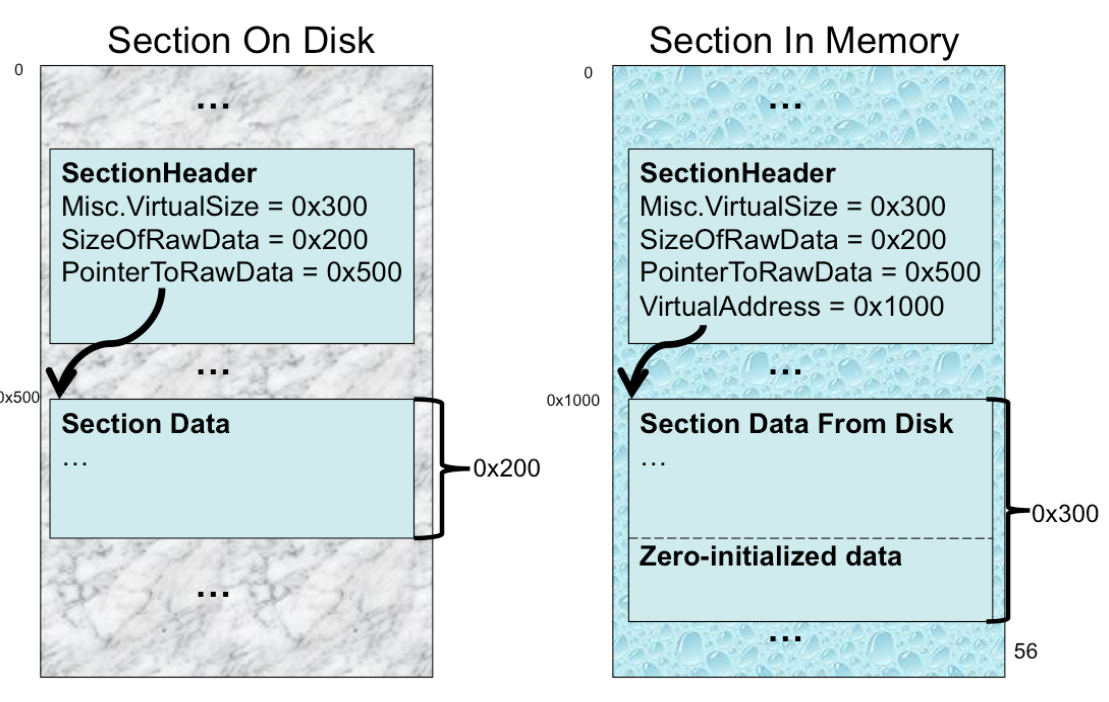
SizeOfRawData > VirtualSize
- PE has the notion of file alignment (stated in
OptionalHeader.FileAlignment). If for example, a binary has0x100bytes of data, the linker would’ve had to write0x100bytes of data followed by0x100bytes of padding - By having
SizeOfRawData>VirtualSize, loader can be like “okay, I only need to allocate0x100bytes of memory and read0x100bytes of data from disk”
Binhunt 3
Note to self:
What is the VA this section will be loaded at?
Answer: 4000
/home/s-b312/Documents/[redacted]/life_of_binaries/BinaryScavengerHunt_03-17-2013/pythondemo/R3Bins
Incorrect. The answer was 0x180004000 (decimal 6442467328)
Score = 2900
- That’s because when he asked for VA, we need to add
0x180000000, which is theImageBaseof the binary with RVA of the section specified. in this case0x4000. So the answer is0x180004000 - Xeno misprogrammed the
Charactersisticsquiz, so the answers to how many flags are always one less than the real number of flags -
:( I didn’t check the video and did the lab first and lose so many points because of that
(this course is a lot lmao)
Static Linking(park) vs Dynamic Linking(park)
Do not open
- With static linking, you literally include a copy of every helper function you use inside the executable you’re generating
- Dynamic linking is when you resolve pointers to functions inside libraries at runtime.
- Static Linking = bloated, independent. Libraries that are included may need to be relink every times there are vulnerabilities need patching or fixes
- Dynamic Linking = lightweight
_IMAGE_DATA_DIRECTORY & _IMAGE_IMPORT_DESCRIPTOR - Import Descriptor
typedef struct _IMAGE_DATA_DIRECTORY {
DWORD VirtualAddress;
DWORD Size;
} IMAGE_DATA_DIRECTORY, *PIMAGE_DATA_DIRECTORY;typedef struct _IMAGE_IMPORT_DESCRIPTOR {
union {
DWORD Characteristics; /* 0 for terminating null import descriptor */
DWORD OriginalFirstThunk; /* RVA to original unbound IAT */
} DUMMYUNIONNAME;
DWORD TimeDateStamp; /* 0 if not bound,
* -1 if bound, and real date\time stamp
* in IMAGE_DIRECTORY_ENTRY_BOUND_IMPORT
* (new BIND)
* otherwise date/time stamp of DLL bound to
* (Old BIND)
*/
DWORD ForwarderChain; /* -1 if no forwarders */
DWORD Name;
/* RVA to IAT (if bound this IAT has actual addresses) */
DWORD FirstThunk;
} IMAGE_IMPORT_DESCRIPTOR,*PIMAGE_IMPORT_DESCRIPTOR;OriginalFirstThunkis the RVA of the Import Name Table (INT).- INT is an array of
IMAGE_THUNK_DATAstructs. - This field of the Import Descriptor points at the first entry in that array
- INT is an array of
FirstThunk- likeOriginalFirstThunkbut points to Import Address Table (IAT)- IAT is also an array of
IMAGE_THUNK_DATAstructs
- IAT is also an array of
Nameis just RVA which will point at the specific name of the module which imports are taken form (e.g.hall.dll,ntdll.dll, etc)
_IMAGE_THUNK_DATA & _IMAGE_IMPORT_BY_NAME
#include <pshpack8.h>
/* Import thunk */
typedef struct _IMAGE_THUNK_DATA64 {
union {
ULONGLONG ForwarderString;
ULONGLONG Function;
ULONGLONG Ordinal;
ULONGLONG AddressOfData;
} u1;
} IMAGE_THUNK_DATA64,*PIMAGE_THUNK_DATA64;
#include <poppack.h>
typedef struct _IMAGE_THUNK_DATA32 {
union {
DWORD ForwarderString;
DWORD Function;
DWORD Ordinal;
DWORD AddressOfData;
} u1;
} IMAGE_THUNK_DATA32,*PIMAGE_THUNK_DATA32;/* Import name entry */
typedef struct _IMAGE_IMPORT_BY_NAME {
WORD Hint;
BYTE Name[1];
} IMAGE_IMPORT_BY_NAME,*PIMAGE_IMPORT_BY_NAME;Hintspecifies a possible ordinal of an imported function. Basically just a way to look up function by an index rather than a nameNameon the other hand is to look up the function by name. It’s a null terminated ASCII string which follows the hint. Usually just null in this course’s examples.
INT vs IAT
- INT’s
_IMAGE_THUNK_DATAstructs are always interpreted as pointing atIMAGE_IMPORT_BY_NAMEstructs, oru1.AddressOfData, the RVA ofIMAGE_IMPORT_BY_NAME - IAT’s
_IMAGE_THUNK_DATAstructs start out all interpreted asu1.AddressOfData, but once the OS loader resolves each import, it overwrites THUNK_DATA with the actual VA of the start of the function, which is more or lessu1.Function
Visual Represent images from the slide

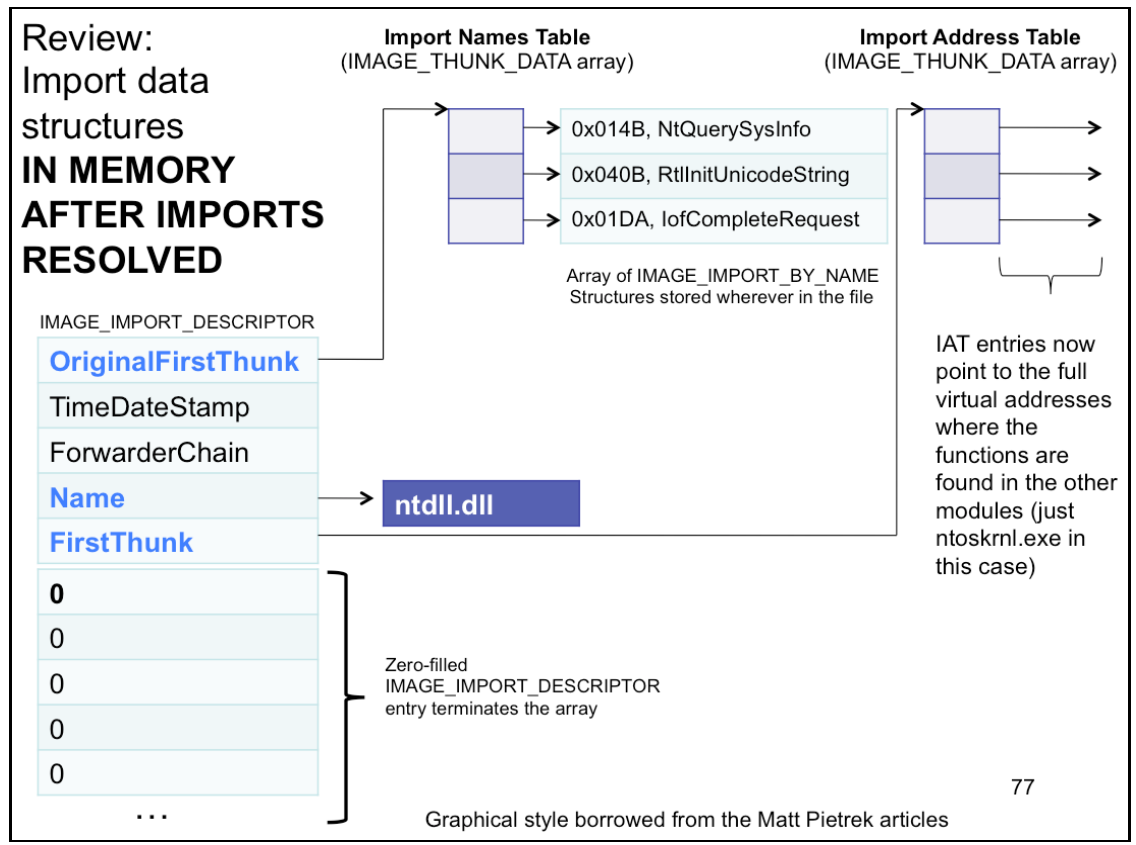
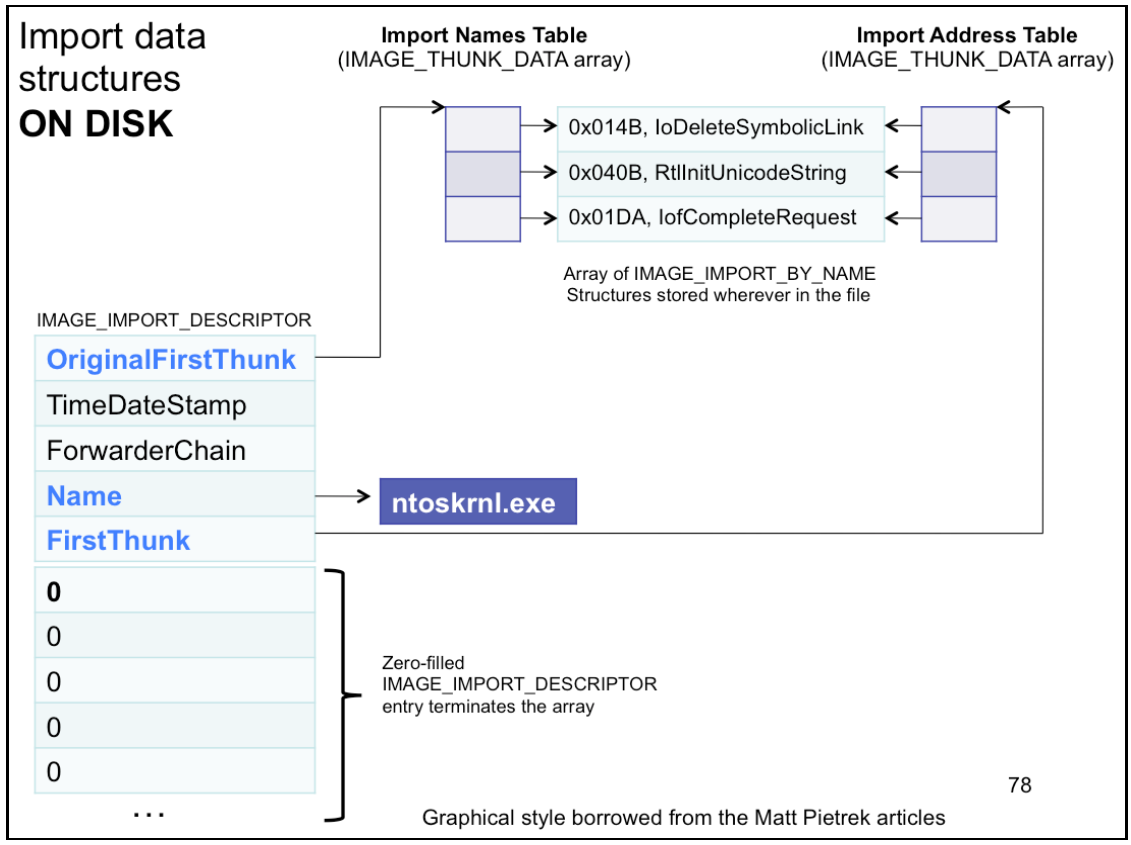
IAT - Image Address Table
IAT Hooking
- When IAT is fully resolved, it’s basically just an array of function pointers
- This mechanism can be exploited because it could be changed after the OS loader is done. It could points at attacker code
- MITM stuff, modifies parameter before forwarding the call to original function, filters results that come back. Or it could be whatever the attacker wants to.
- How tho?
- From the slide, the flow is generally like this:
- Arbitrary code execution → changing memory (like IAT for this particular process)
- and since each process has their own separate memory space, if the attacker wants to change IAT of other processes, he/she needs to do do the same for each process.
- That’s time consuming, so the attack instead performing DLL injection as a way to leverage IAT Hooking across many userspace processes. Because kernel modules are generally all sharing the same memory space with the kernel.
- Therefore subverted kernel module can hook IAT of any other modules it wants
DLL Injection
go do the lab yourself lol
Bound Imports
- Import binding is a speed optimization. The address of the functions are resolved at link time, then placed into the IA
- The binding is done under the assumption of specific versions of DLLs.
- If DLLs change, then all IAT entries will be invalid.
- so you gotta resolve the addresses again, not much worse off than if you had not used binding in the first place
IMAGE_DIRECTORY_ENTRY_BOUND_IMPORT
typedef struct _IMAGE_DATA_DIRECTORY {
DWORD VirtualAddress;
DWORD Size;
} IMAGE_DATA_DIRECTORY, *PIMAGE_DATA_DIRECTORY;